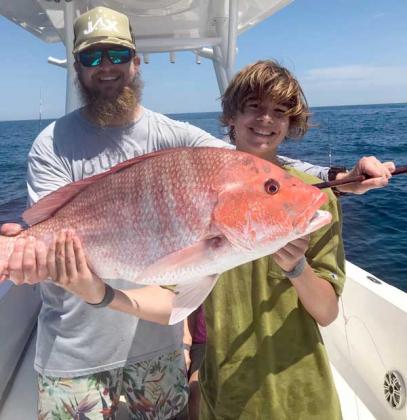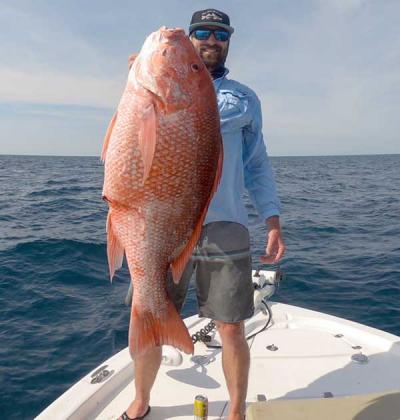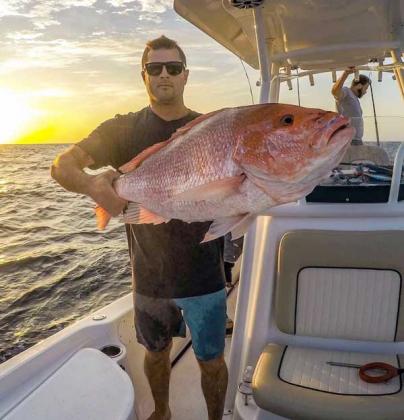One more day. Tomorrow, Friday the 17th, is the last day of the Atlantic Red Snapper season for 2020. If you’re planning on fishing from Jacksonville, remember tomorrow is also the last day of the Greater Jacksonville Kingfish Tournament. Any ramp remotely near the inlets will be crowded for snapper already; add a major tournament to the mix, and it will be complete chaos by sunrise. Bring a healthy dose of patience and plan on waiting and walking more than normal. Last weekend had trailers parked all the way to Little Jetties Park, and I would expect the same or worse on Friday.
The good news is once you make it out of the inlet, the fish have been chewing – a limit of snapper should take minutes if you’re in the right spot. With the season so short and the limit being one a person, I’ve been focusing on the bigger snapper. To catch one over 10 to 15 pounds will test your gear, and the first 50 feet off the bottom is an absolute battle. After last weekend, the most common question I’ve gotten is how to get away from the little 2- to 4-pound chickens and catch bigger fish, so that’s what we will cover in this week's article. Note this is not how you want to fish every set up on the boat, and it’s not how to catch the most snapper, but it’s how we consistently put fish over 15 pounds in the boat.
For tackle, you want heavy spinning gear, or conventional reels with stout rods and tight drags. I like the drag tight enough that you can’t pull the line off with your hand. The reels I use are varied from 30 to 40 pounds of pressure at strike to 50 to 60 at full. With this much drag, you have to have heavy rods and hold on tight, but it will keep the bigger snapper and grouper from beating you in that crucial first minute. Mainline is 60- to 80-pound braid connected to a 15- to 20-foot topshot of 80- to 100-pound mono. Slide an egg weight just heavy enough to get the bait down on the topshot above a swivel and then use 10 to 15 feet of fluorocarbon leader to a 6/0-8/0 circle hook. For the fluorocarbon, I start with 80-pound most days, but use anything from 50- to 130-pound, depending on conditions and how the fish are acting. If you aren’t getting bites, go lighter; if you’re over a wreck with lots of relief and twisted metal for the fish to wrap you up, in then go heavier.
For big snapper, you want a bait about the size of your palm; a live grunt or pinfish is ideal – pogies will also work, so will threadfin. For frozen baits, sardines, cigar minnows, or Boston mackerel all work well. Make sure the hook you use is the right size for the bait. These fish are old and have seen it all before; if it looks unnatural, it won’t get eaten as fast, or even at all. For pogies and threadfin 6/0, bigger grunts 8/0.
With a bait this size you reduce the small bites, but sacrifice number of opportunities; be sure to make them count. If you leave the big bait setup in the rod holder and don’t keep a close eye on it, you’ll miss the tap tap tap of a snapper smashing that bait and either taking it or feeling the steel and moving on. If you're bringing up baits that look like they’ve been hit by a truck, you’re on the right spot. Don’t set the hook on the strike; let the circle hook work the way it was intended. When you feel the taps, don’t react at all; once the rod tip starts to load up and head toward the water, just start reeling and hold on tight.
A 20-pound fish will bulldog toward the bottom hard and rip more line off that reel then you thought possible. You’ve gotta get some ground made up before that snapper gets your line wrapped around the wreck or ledge you’re fishing. This is where the long topshot helps; with drag locked down, it’s providing some stretch as the fish fights, and if you do get wrapped up in the bottom, the mono has far more abrasion resistance than any braid will. Once you get the fish off the bottom, it’s no time for a break; the sharks have been bad this year and if you don’t get it to the boat quick, that big fish you just fought off the bottom will go right to the tax man. From the time you set the hook till the time the fish hits the deck, that reel handle needs to be turning as fast as you can turn it.
Good luck out there this weekend, and if you get a good one, send us some pictures of your catch to be posted in next week's report.
For any questions or to book a charter, send an email to Chris@fishjax.org.



